
What is clickbait?
It’s a marketing tactic intended to draw attention and entice users to click through.
But clickbait is by and large considered a misstep in marketing, intended to mislead and dupe users into clicking spammy content.
So, is it ever acceptable to use clickbait? Read on to find out.
What You’ll Learn:
- What Exactly IS Clickbait?
- Why It’s Effective
- The Case for Using Clickbait
- When to Avoid It
- How to Use Clickbait the Right Way
Clickbait gets a bad rap.
Years of overuse and abuse have done a number on its reputation, leading many to ban the practice altogether.
For example, Facebook’s algorithm figured out that its users despise clickbait, leading to the social media giant taking a stand against the practice.
Both legitimate and “fake” news sites have adopted the practice to get more eyes on their content. NPR reports on how Upworthy, the poster child of clickbait headlines, faced an early demise because of its tendency to overdo the hype and underdeliver the story.
Their story is a perfect example of how NOT to use clickbait.
But clickbait isn’t a new phenomenon, and there’s still a time and place for it in marketing.
What Exactly IS Clickbait?
In its purest form, clickbait is simply content aimed at grabbing users’ attention and enticing them to click.
But over the years, it’s gained a reputation as false advertising.
Tech Crunch defines clickbait as the act of intentionally misleading an audience about the content of an ad or news story, typically through a headline, image, or caption.
You’ve certainly seen examples floating across the web, leading with phrases like “you won’t believe what happens next!” or “this will shock you!”
The problem with clickbait is that it uses a bait-and-switch method. It grabs attention immediately but fails to deliver when a user clicks through. Understandably, this leads to frustration and even resentment on the user’s part.
Take this example:
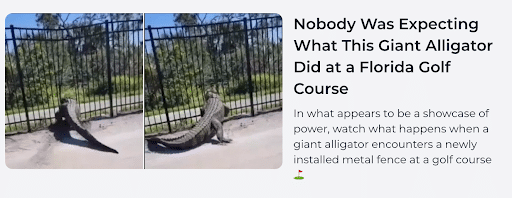
An Example of Clickbait Gone Wrong
It grabs attention because, well, it’s weird, and it seems scary. It’s not something you hear every day so you want to know what it is.
Turns out, it doesn’t do anything crazy or attack anyone. It just crawls through the fence, exactly as the picture shows. That doesn’t quite live up to what the headline promised, does it?
But not all clickbait is bad, and when used correctly can be a powerful addition to a marketer’s arsenal. The difference is in the delivery.
If you can develop good clickbait and deliver on the premise, the users are far more likely to forgive your use of it.
Why Does Clickbait Work?
Clickbait’s continued success comes down to the way people think.
Psychology Today links the success of clickbait to how we as humans forage for information – we always want more.
Our brain releases dopamine to reward us for doing positive actions, and when we click on an interesting headline, we get a shot of that chemical directly into our brains. The words in clickbait headlines prey on that want, compelling us to click so we’ll get that quick shot of dopamine as a reward for giving in to our curiosity.
A joint study, performed by the Federal University of Minas Gerais in Brazil and the Qatar Computing Research Institute found the most compelling headlines that exist are the ones that polarize the audience.
The extreme opinions generated the most interest. By introducing information we may not know, the headline compels us to find out more. Clickbait is an easy way to hook a reader from the get-go.
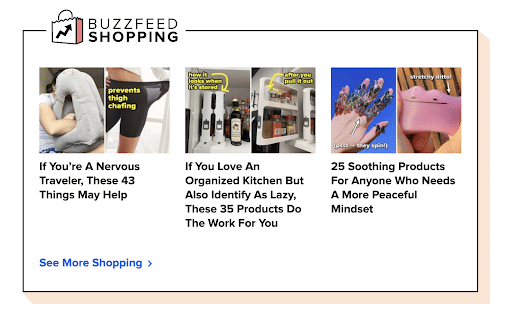
An Example of Clickbait Using FOMO
Clickbait also plays into the FOMO effect, or fear of missing out. If you tease someone with information, they’ll naturally need to close the curiosity gap; otherwise, the risk of missing out.
Clickbait isn’t an automatic method of getting readers’ eyes on content, however.
If you misrepresent what your content is about in a headline, you risk driving your audience away instead of keeping them interested. There are specific instances where clickbait is perfect for catching the audience and reeling them in, and on some occasions when it doesn’t work at all.
When SHOULD You Use Clickbait?
There are a few times when a business might look at clickbait as a handy marketing solution.
It’s not a wonder drug or a quick fix, however. Using clickbait comes with massive expectations for the content to live up to the hype.
Always exercise caution. If you’re unsure if a headline accurately reflects its content or don’t think the quality warrants the hype clickbait could provide, avoid using it altogether.
Generally, clickbait works best in these situations:
Driving Traffic to a Website
Clickbait will drive traffic to your site; after all, it’s designed to entice clicks.
Whether that traffic count comes down to whether your content delivers on the expectation or not. Again, make sure it delivers on its promise and leads to a high-quality page.
The best way to avoid an immediate bounce is to make your content less advertorial. As the New York Times states, people, despise ads.
The less “salesy” our content is, the more likely the audience will click through to the rest of our content.
Here’s an example from Shopify.
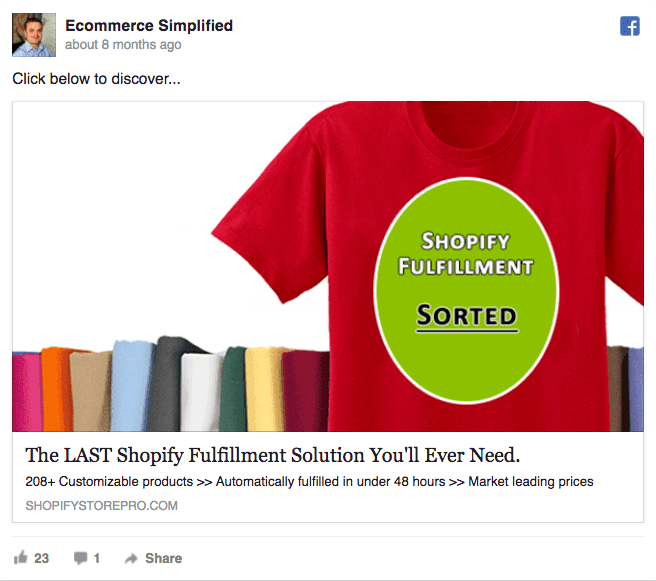
Clickbait headlines shouldn’t come across as sales pitches
They’re trying to get you to check out their product, but doing it in a way that offers a benefit to users. They’re not asking users to buy; rather, they’re asking them to learn more about their unique solution.
Here is another example of clickbait being used to make sales, without coming across as a sales pitch:
The goal of this graphic is obviously to drive people to the sales pages linked in this article but it’s wrapped up in the disguise of a fun list of interesting products. The photos featured and headline copy used pulls the viewer in and drives them to the site.
Attempting Viral Marketing
The critical word here is “attempt” since no one can guarantee a piece of content will blow up and get shared all over the internet.
However, smart clickbait can get people to want to share things.
While it won’t guarantee your post will go viral, it might encourage more people to share it around, giving it wider exposure.
As more people see your content, the chances of it taking off and going viral increase. The eye-catching headline makes it easier to get people reading.
To Share a Message
Value-based marketing isn’t about promoting products and services. It’s about promoting values.
It appeals to users’ emotions and pain points by laying out the unique value a brand brings to the table. Because clickbait often relies on an emotional trigger, it can be well-suited to this kind of marketing.
The side effect of this kind of promotion is that it may increase the audience’s interest in the brand that shared it. Sharing on-brand messages are an excellent way to help a business gain visibility and credibility within an industry.
Here’s an example from Hear.com.
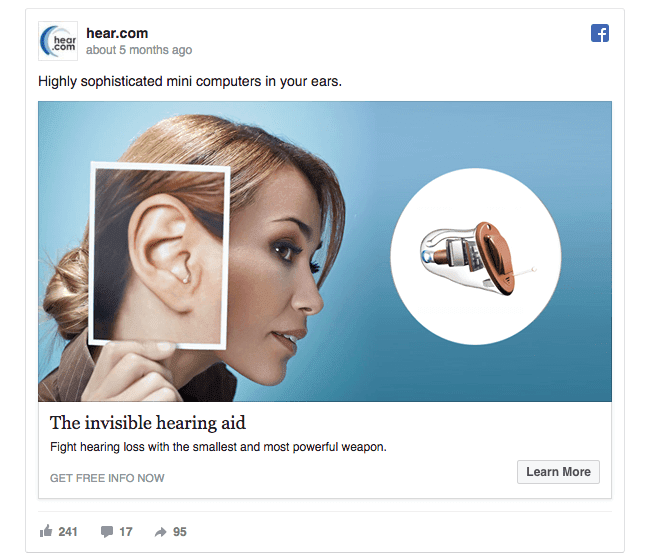
You can use clickbait to highlight unique values
While yes, they are selling a product, they use their teaser text to grab attention (mini-computers in your ears! Who wouldn’t want to know more?) and touch on its value proposition in the headline.
But beware; when using clickbait to push values, you must deliver on the end of the click, or this tactic can go wrong very quickly.
To Increase Clicks
While most of us in digital marketing are here for a good reason, it doesn’t negate the fact that we do need to entice people to click on our work if we want to get our message across to them.
One place where you’ll really see this is on YouTube.
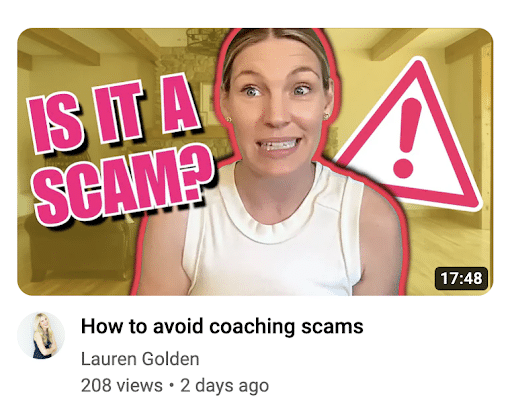
Take this YouTube thumbnail for example. When you look at it, it probably makes you think “I don’t know! Is it a scam?!” You may not even know what the presenter is talking about but now that she’s piqued your interest, you’re going to click on her video to find out if she got scammed or not.
That’s how clickbait works. It entices you to click on the video. In this situation, the copy is simple but the graphics and the font are what drives home the feeling of importance.
When to Avoid Using Clickbait
Too many marketers use clickbait when they shouldn’t.
The result is that the entire concept gets a bad reputation. Clickbait is a tool, and like any other tool, it can help or hinder its users. Clickbait isn’t a bait-and-switch and shouldn’t be used as such.
A lot of the negative press the tactic gets comes from marketers and journalists leveraging it to drive views without a care for the audience’s time investment. Just like there are specific use-cases where clickbait is good, there are some times when a company just shouldn’t adopt it as a marketing strategy.
Some of these situations are:
When You Can’t Deliver on the Headline
People put a lot of value on their time.
They don’t appreciate it when a headline builds them up for something and doesn’t deliver on its promise. If anything, it makes them wary about anything you might offer them.
If you can’t deliver on the hype your headline offers, then we should just avoid it altogether.
When You Have Incorrect or Incomplete Information
It’s tempting to use information that aligns with our values to sell a product. The chances are good that it will even get some clicks and develop a following.
However, if the truth comes out, and it doesn’t align with our content, we lose the trust of every member of the audience we initially converted. If your information is incomplete or blatantly inaccurate, we should avoid clickbait altogether.
While it’s never recommended that you use false information, you may be covering a story as it unfolds or anticipating new developments. If that’s the case, don’t promote clickbait that promises full answers you don’t yet have.
When You Are Trying to Drive Sales
Clickbait isn’t and shouldn’t be used as a sales pitch.
It comes off as disingenuous and gives in to the preconceptions of the audience. Clickbait isn’t the vehicle to drive direct sales. If that’s what you want to do, then your aim should be towards paid ads, not towards creating clickbait content.
When It Will Do More Harm Than Good
There is a time and a place to use clickbait. In situations where it will damage your brand integrity, you should skip it.
Take something like The Sun for example.

Another Example of Clickbait
There is probably some really good information in this magazine but years of clickbait headlines and false accusations have branded The Sun as a tabloid. Since they’ve used inaccurate information and flashy headlines as a way to grab readers’ attention for so long, it has become an untrustworthy source.
In this instance, the use of continual unsubstantiated clickbait gave this brand a reputation that it probably didn’t want.
Learning the Art of Clickbait
Though the ‘clickbait’ title is relatively new, the actual marketing tactic has been around for years.
While the method and medium of delivery have changed, the content and aim remain the same. Swiped mentions an ad that features a clickbait headline, published in 1927. So, as you can see, clickbait was used way before websites and Google entered the game.

An example of early clickbait
This demonstrates the good side of clickbait. Remember, at the end of the day, it’s simply a marketing tactic aimed at influencing people to buy a product, which marketers have been using since the early twentieth century.
From this ad, we can realize that the art of clickbait is to offer hope and then deliver on that promise. It aims to seize the user’s attention and put their eyes on something of use to them.
Grabbing Attention With Headlines
Successfully using clickbait is all about mastering the art of the headline.
A clickbait headline is one that offers a fun, intriguing, and exciting premise to the reader.
It can come in several different forms, each one focusing on a different part of our audience’s hopes and fears. Marketers understand the use of the term “pain points” when talking about what motivates buyers.
These “pain points” are also present in people’s minds. These are the things that three of the most popular and useful clickbait techniques focus on.
3 Types of Useful Clickbait
Obtaining a clear understanding of how to use clickbait requires us to break down these three techniques: The Newsjack, Shock Topics, and Cliffhangers.
The Newsjack
Newsjacking takes a legitimate, newsworthy topic and then adds intrigue and mystery to it.
It’s not a new technique – PR firms have been doing it for decades to get free publicity. As mentioned before, polarizing headlines are sure to get people interested, and including a polarizing issue in a headline will get people wanting to click on your content link.
The general format of the headline goes along these lines:
[Person/Brand/Company] Secretly Mentions to [Person/Brand/Company] What Their REAL Opinion Is Of [Polarizing Topic]
If you adjust the words and change the people or brands, you can create a buzzworthy news title that just needs the blanks filled in.
Here is an example of newsjacking:
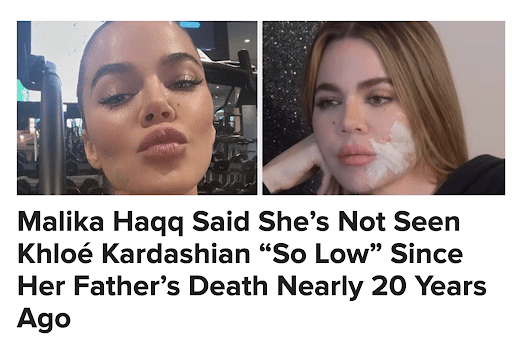
This article uses one of the internet’s biggest names – a Kardashian – to drive clicks. Anyone who is interested in celebrity gossip, reality TV, or influencer drama is going to be interested in what is going on with Khloe Kardashian these days. They list her well-known friend – Malika Haqq – as a way to tease that they know something that you don’t. Then they throw in Khloe’s father’s death for shock value.
So what is making Khloe so upset and what does Malika have to say about it? Guess you’ll have to read the article to find out!
Shock Topics
People don’t expect news to shock them, so when someone or something performs an unexpected action, everyone wants to know about it.
The mainstay of the muckraking journalist since time immemorial, a “shock topic” can cover the taboo societal discussions such as sex, politics, race, and religion – the topics that most experts agree you shouldn’t talk about in polite company.
The general format of these headlines goes:
[Person/Group] Does/Says [Inappropriate Thing] at [Controversial Setting]
Or:
The [People Against An Issue] Are Using This Shocking [Photo/Image Of Issue] To [Change Minds/Create Chaos/etc.]
This is an example of a shock topic type of clickbait:
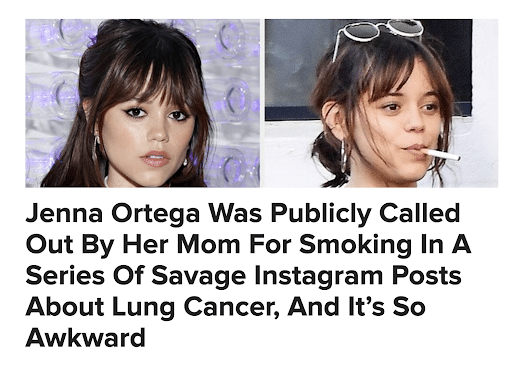
It takes one of Hollywood’s most popular young actresses, Jenna Ortega, and pairs it with the scandalous action of cigarette smoking. Then it adds shock value by mentioning the way her mother reacted. The purpose is to drive people to click on the link by seeing the “awkward” exchange.
Sure you know that cigarette smoking is bad but what other websites are going to show you how a current It Girl is being shamed by her mother on the internet?
Cliffhangers That Draw Readers In
Cliffhangers, like clickbait, have a bad rap.
Some people like them, some hate them, but regardless of the audience’s opinion on them, they will always want to know more.
A cliffhanger is designed to encourage the reader to click. It offers them a tease of the topic without a satisfactory ending, making them want to click on the link to learn more.
Some standard forms of cliffhanger titles include:
The Things No One Mentions About [Controversial Topic]
Or:
[Overhyped Thing] vs. [Other Overhyped Thing] in The World Today
Here is an example of a cliffhanger:
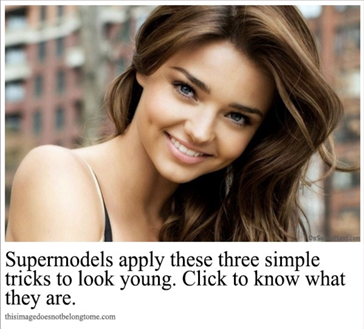
Cliffhanger
The goal of this photo is to make you wonder what three simple things this supermodel does to look young. If you want the answer, you have to click on the picture.
It’s playing into your human sense of wonder. How does this woman look so beautiful? You would have to click on this photo to find out!
Here is another example of a cliffhanger:

Thanks to the recent live-action movie release, the Little Mermaid is a huge trending topic right now. This article jumps onto that train by posting two “easter eggs” and then enticing you to click and learn the other 21.
Want to know what you missed in the movie? You would have to click on this Buzzfeed article or you’ll never know!
Wrapping Up
Even if social media and Google have it out for clickbait, it isn’t dead just yet. It just takes a bit more skill to craft and deliver.
The critical concept to keep in mind when developing clickbait is that the hype shouldn’t overreach the delivery. Just like other types of content marketing, the reader shouldn’t feel as though their time was wasted.
Once you accomplish that, you succeed where others have failed in making clickbait a viable marketing strategy.
